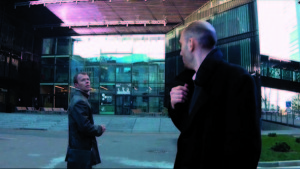I was quite excited when about a year ago it was announced that the students of the Baltic Film and Media School (BFM) would produce a series of shorts on contemporary Estonian architecture. ‘Finally!’, I thought. My expectations were raised even higher when I read the following introduction on the web page of the Union of Estonian Architects:
“How to present architecture? How to make people outside architectural circles understand it or to be interested in it? [—] How to address someone who encounters architecture daily, both in the office and at home, working or resting? How to communicate an architect’s visions to them?
How to create an interface between architecture and cinema? And to do it so that architecture isn’t merely a random decoration, but rather an active agent, as in Jacques Tati’s Playtime or Mon Oncle, or in Stanley Kubrick’s The Shining?”

Flow and Ebb (Tõus ja mõõn). 6’16”. The film is about the nominee of the 2012 Cultural Endowment’s architecture award: Boatshed of the Vilsandi Marine Rescue Station. Director- screenwriter: Anna Hints
Unfortunately, the six shorts completed by the students of BFM did little to live up to these expectations, as in comparison with Tati’s and Kubrick’s complex features they came across as empty, replete with all kinds of cinematic and narrative stereotypes, and easily forgettable. The above-quoted introduction called for a mode of presentation which would provide more substance than just ‘carefully chosen camera angles; straight, optically manipulated vistas’, yet in most of the films the neat cinematography is clearly the dominant element of the representational regime, perhaps especially so in Flow and Ebb (Tõus ja mõõn, directed and written by Anna Hints). Close-ups of wooden or concrete surfaces, flashy angles and meticulously framed views of buildings and their surroundings might indeed present viewers with a certain sense of contemporary architecture as desirably elegant and modern, and perhaps even give clues to the sensitive relationship with their immediate environment. However, the films did not succeed (or weren’t interested) in digging deeper into the layers of social, cultural and historical relevance and associations, or did so by means of hackneyed images and stale stereotypes.

Air Castle (Õhuloss). 4’10”. Director-screenwriter: Marleen Roosna. The film is about the nominee of the 2012 Cultural Endowment’s architecture award: Seaplane Hangars.
For example, the author of Air Castle (Õhuloss, directed and written by Marleen Roosna), which portrays the Seaplane Harbour, chose to include a rather off-topic and banal reference to the sinking of the Titanic, yet paid no attention to the significant fact that the impressive hangars of the harbour, now housing the Maritime Museum, were the world’s first reinforced concrete shell structure. The Third (Kolmas, directed by Maria Reinup, written by Greta Varts and Maria Reinup), filmed in the Tartu Health Care College, verges on the pornographic with its objectified presentation of a sexy ginger-haired nurse, without considering the controversial nature of such an image. While Zone (Tsoon, directed by Andrew Bond), presenting the home of the Baltic Film and Media School, is somewhat amusing in its paraphrase of Andrei Tarkovsky’s Stalker (Сталкер, 1979), the association between the film and the film school in Tallinn, located quite close to the place where Tarkovsky shot part of Stalker, is rather predictable and clichéd, especially considering Tarkovsky’s position as a sort of ‘holy cow’ in the local film scene. By the same token, The House That Reflects History (Maja, mis peegeldab ajalugu, directed and written by Doris Tääker), introducing the exquisite architecture of Narva College of the University of Tartu, conjures up quite predictable associations with the city’s glorified and long-lost Baroque history, instead of taking up more intriguing and pressing issues of its present (including those related directly to, and addressed by, the building’s design, both architectural and interior).

Zone (Tsoon). 7’35”. Director-screenwriter: Andrew Bond. The film is about the nominee of the 2012 Cultural Endowment’s architecture award: the Baltic Film And Media School. www.youtube. com/watch?v=v3coXznoBc
All in all, these shorts demonstrate a striking – and dangerous – lack of critical thinking and testify to a gravely worrying tendency to avoid asking uncomfortable questions and to shy away from presenting viewpoints that go against the grain of the socio-cultural mainstream. What they also demonstrate is an apparent inadequacy of instruction: while the ignorance of students might be excused due to youth and inexperience, the inability of their teachers to encourage them to pay due attention to artistic research (of both historical resources and subject matter), to go against the flow and to acquire a critical edge comparable to Tati and Kubrick is certainly not. In marked contrast to both Jacques Tati and Stanley Kubrick’s works, these films come across as shallow commercials, promoting the dominant discourses and following tediously ‘safe’ modes of representation, despite the fact that their subject matter provides ample potential for just the opposite.
The House That Reflects History
(Maja, mis peegeldab ajalugu).
6’22”. Director-screenwriter: Doris Tääker.
The film is about the nominee of the 2012 Cultural Endowment’s architecture award: Narva College of the University of Tartu.
Design Lighthouse
(Disainimajakas).
4’21”. Director-screenwriter: Janis Rizhovs.
The film is about the Kuressaare Regional Training Centre.
The Third
(Kolmas).
6’43”. Director Maria Reinup.
The film is about the nominee of the 2012 Cultural Endowment’s architecture award: Tartu Health Care College.
Zone
(Tsoon).
7’35”. Director-screenwriter: Andrew Bond.
The film is about the nominee of the 2012 Cultural Endowment’s architecture award: the Baltic Film And Media School.
Flow and Ebb
(Tõus ja mõõn).
6’16”.Director- screenwriter: Anna Hints.
The film is about the nominee of the 2012 Cultural Endowment’s architecture award: Boatshed of the Vilsandi Marine Rescue Station.
Air Castle
(Õhuloss).
4’10”. Director-screenwriter: Marleen Roosna.
The film is about the nominee of the 2012 Cultural Endowment’s architecture award: Seaplane Hangars.
